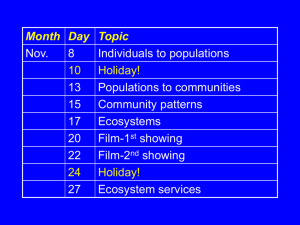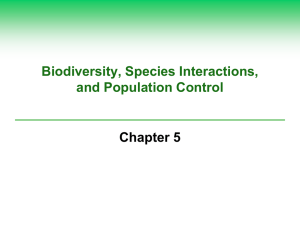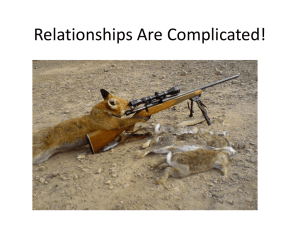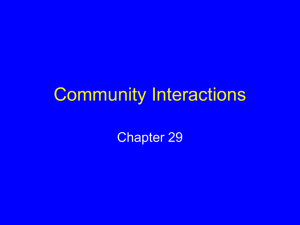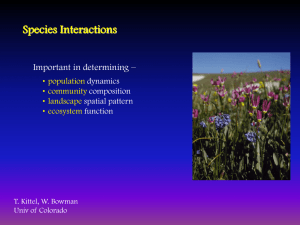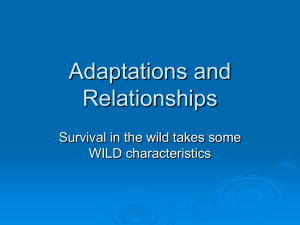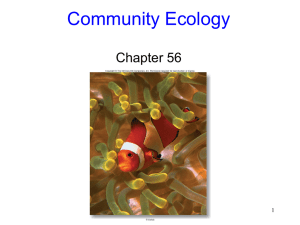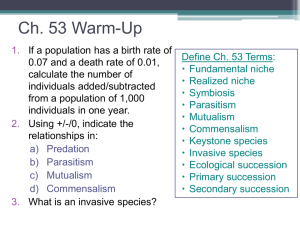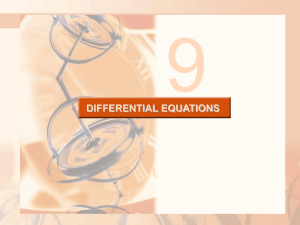Commensalism
advertisement
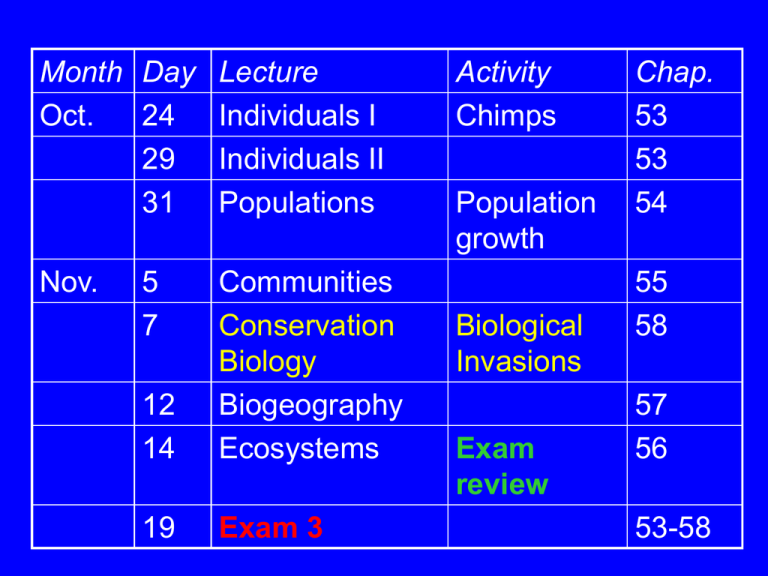
Month Day Lecture Oct. 24 Individuals I 29 Individuals II 31 Populations Nov. 5 7 12 14 Communities Conservation Biology Biogeography Ecosystems 19 Exam 3 Activity Chimps Population growth Biological Invasions Exam review Chap. 53 53 54 55 58 57 56 53-58 Outline • What determines where a species lives? • Communities • Ecological interactions A population is: A population is: A group of individuals of the same species living in a given area at a given time. What controls where a population lives? What controls where a population lives? • It has to get there – Evolution – Dispersal What controls where a population lives? • It has to get there – Evolution – Dispersal • Its ecological niche Key concept in ecology: the niche Key concept in ecology: the niche • Fundamental niche – Abiotic conditions that the species can live within Key concept in ecology: the niche • Fundamental niche – Abiotic conditions that the species can live within • Realized niche – Biotic interactions that reduce or enhance the fundamental niche Barnacle story, figure 55.1 Balanus’ fundamental niche: upper, middle and lower zone Balanus’ realized niche: middle zone, limited from upper by competition, lower by predation Interactions among populations determine a species realized niche... A community is: A community is: Populations of different species that live together in a given area at a given time. Communities are... • Defined by abiotic factors – Populations in a community have similar fundamental niches Communities are... • Defined by abiotic factors – Populations in a community have similar fundamental niches • Defined by biotic interactions – Some are weak – Some are strong Types of community interactions Individual 2 Harm Ind. 1 No effect Benefit Harm Competition Amensalism Predation or Parasitism No effect Amensalism Commensalism Benefit Predation or Commensalism Mutualism Parasitism Types of community interactions POP. 2 POP. 1 Harm No effect Benefit Harm Competition Amensalism Predation or Parasitism No effect Amensalism Benefit Predation or Parasitism Commensalism Commensalism Mutualism Types of community interactions POP. 2 Harm POP. 1 No effect Benefit Harm Competition Amensalism Predation or Parasitism No effect Amensalism Commensalism Benefit Predation or Commensalism Mutualism Parasitism Types of community interactions POP. 2 Harm POP. 1 No effect Benefit Harm Competition Amensalism Predation or Parasitism No effect Amensalism Commensalism Benefit Predation or Commensalism Mutualism Parasitism Keys to competition (-/-) • Organisms compete for limited resources Keys to competition • Organisms compete for limited resources • Can be: – Intraspecific Time Population size Keys to competition • Organisms compete for limited resources • Can be: – Intraspecific – Interspecific Figure 55.2 Competition can: • Restrict species ranges Competition can: • Restrict species ranges • Reduce species abundances Competition can: • Restrict species ranges • Reduce species abundances • Cause the local extinction or competitive exclusion of species from an area Figure 55.3 The ghost of competition past... Predator-prey interactions (+/-) • Predators are generally larger than their prey (but many exceptions...) Predator-prey interactions • Predators are generally larger than their prey (but many exceptions...) • Predators live outside of the body of their prey Predator-prey interactions • Predators are generally larger than their prey (but many exceptions...) • Predators live outside of the body of their prey • Predators generally kill their prey Predator-prey interactions • Dynamics of predator and prey populations may be: Predator-prey interactions • Dynamics of predator and prey populations may be: • Loosely coupled – predator “switches” when prey is scarce • Tightly coupled – predator starves when prey is scarce Tightly coupled predator-prey interactions change over time • An evolutionary “arms race” Tightly coupled predator-prey interactions change over time • An evolutionary “arms race” • Mimicry Batesian mimicry • Figure 55.10 Batesian mimicry • Figure 55.10 Predator-prey interactions change over time • An evolutionary “arms race” • Mimicry • Plant defenses against herbivores Host-parasite interactions (+/-) • Parasites are generally smaller than their hosts • Parasites live inside or on the body of their host • Parasites generally kill their hosts more slowly than predators Amensalism (0/-) • Figure 55.11 Commensalism (0/+) • Figure 55.12 Mutualisms (+/+) Mutualisms can be loose or tight Picture of cleaner wrasse picking parasites off of other species of fishes Figure 55.13 Picture of cross section of acacia thorn stuffed full of ant larvae Acacia with ants Figure 55.14 Acacia without ants
